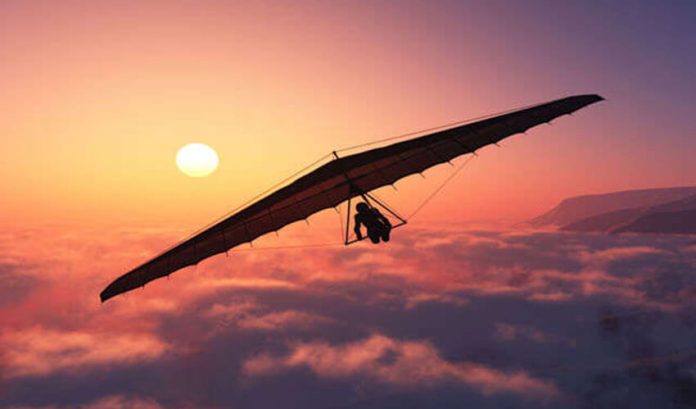Los Pozos is a curious place, located on the edge of kilometers and kilometers of featureless salt flats and at the foot of a sheer cliff wall rising straight up for 595 meters. And one of its curiosities is what happens when hot air rising from the flats encounters the high cliff wall.
“Termales is what happens,” says hang gliding expert Pedro Kordich. “You call them thermal updrafts in English, and they are what we wait for, what we live for, just as surfers wait for the big waves.”
When thermals are good, hang gliders launch from the top of the cliff and soar, hover and then gently float to a new position. The thermal lifts them higher and higher.
”This is our game, floating and floating, rising and descending and rising again,” Kordich said. “This is surely the very maximum for a bird, the quintessence of flying, and it is effortless; it is pure freedom, and it is pure joy.”
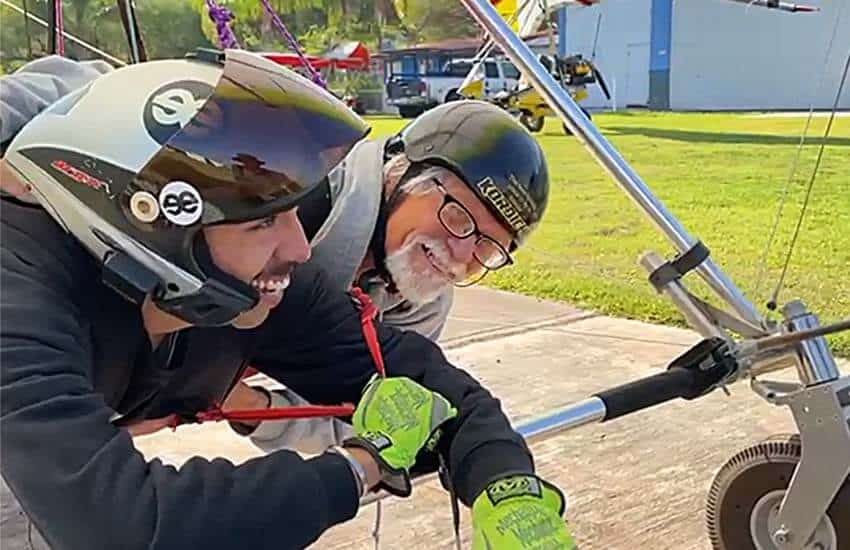
This is why he established Kordich Air Sports at Los Pozos, located 40 kilometers southwest of Guadalajara. He advertises it as “the best @#$%-ing place to fly in Mexico.” On two occasions, Kordich has invited me for a glimpse into the rapture that hang gliding enthusiasts experience.
If you’re only familiar with the sport in a desultory way and haven’t been paying attention to it in the last decade or more, your image of hang gliding may consist of intrepid souls on a glider throwing themselves off cliffs into the wild blue yonder, but at Kordich Air Sports, you can launch yourself safely from a runway on the ground.
Let me explain just what this interesting hang glider is about: also called a delta wing, it is the result of NASA engineer Francis Rogallo’s 1960s research into kites and parachutes. Rogallo wanted to use the delta wing tech to bring spacecraft back to Earth, but other people worldwide thought of additional uses.
In the delta wing, the pilot, wearing a harness, hangs beneath the V-shaped wing and controls it simply by shifting his or her weight to either side of a large, tubular triangle rigidly attached to the wing’s frame. Pushing the triangle’s horizontal bar forward slows you down, and pulling it speeds you up.
That such a simple steering system is so precise as to allow an experienced pilot to land on a 10-peso coin is almost unbelievable.
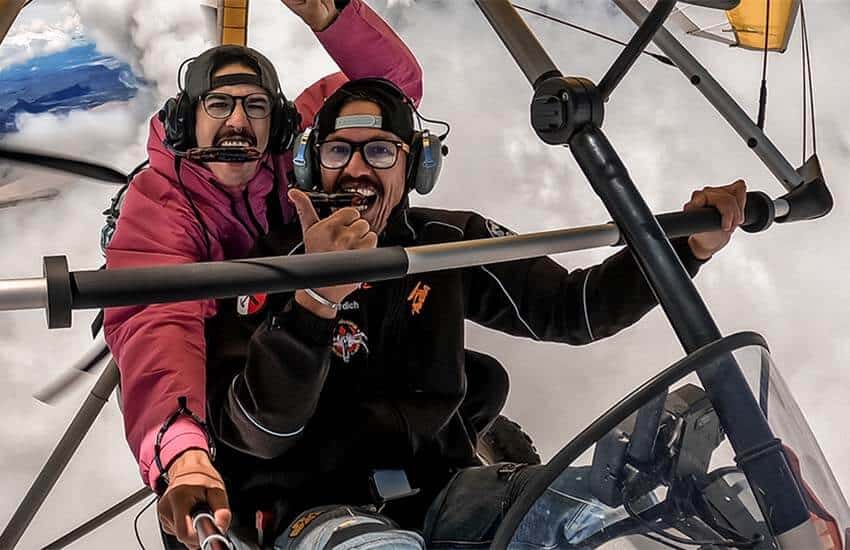
I have now witnessed this miracle twice, at the side of an expert; and at neither time did I have to jump off a cliff to get flying. My first flight was in a trike: a delta wing with a motor, propeller and wheels. These make it possible for it to take off from the ground.
On that first time, I sat behind Kordich as we sped down the runway. I soon had a panoramic view of the wide salt flats and wetlands, the towering cliff and, just beyond, beautiful Lake Chapala stretching as far as the eye could see. Then, suddenly, it was quiet… Pedro had turned off the engine — and we were not falling!
The second time I went, my glider had no motor at all.
When the sport of hang gliding began, you had to drive up to a high, sheer precipice, put on a harness and attach yourself to the delta wing. Then came the part that really required cojones.
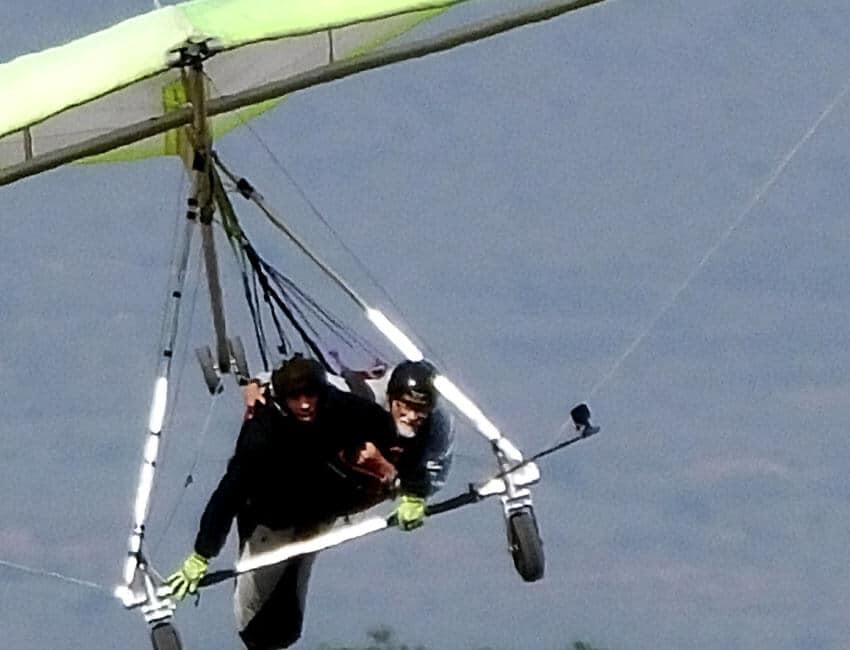
Lifting your delta wing above your head, you would run straight for the edge of the chasm, jumping not to your death (hopefully) but to your joy. Steering is miraculously accomplished by pushing the bar left or right. Free as a bird, you glide, soar and catch a thermal — and rise even higher.
Landing is the most difficult part: you approach the ground at a height and speed normally reserved for a nasty crash. Then, at the very last second, you “stall” your hand glider — and that’s all there is to it, heh, heh.
With this flight, I didn’t worry about landing problems because my flyer had wheels and we had Kordich’s runway at our disposal. Thanks to Kordich’s clever idea, he could launch gliders from the cliff’s bottom.
“What we do,” his son Mile explained, “is attach the delta wing to a long cord and pull it with a trike. We call it a tandem flight because you fly side by side with an expert. This way we can give people a true experience of hang gliding.”
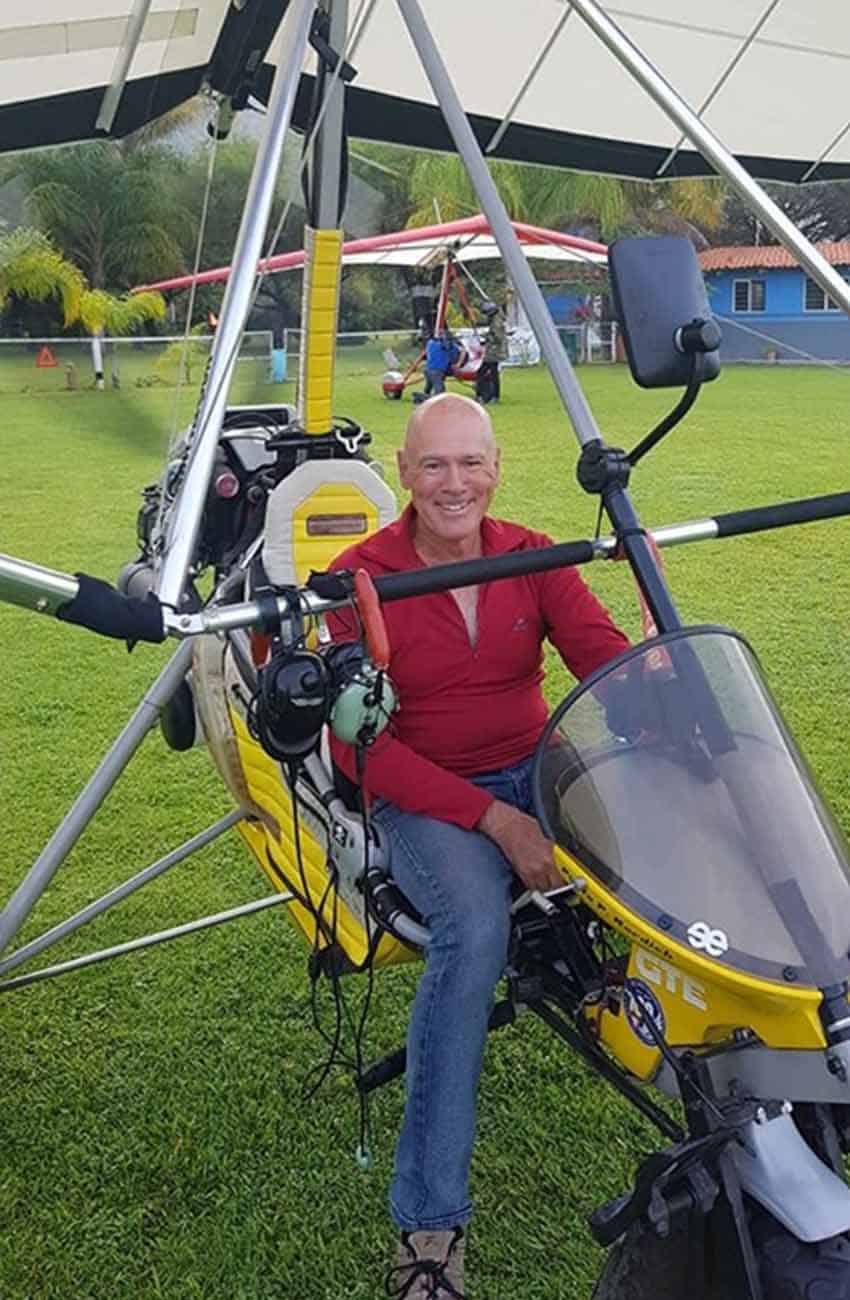
To try it, however, you must weigh less than 80 kilos.
Mile and I both put on helmets and got into full-body harnesses that looked like sleeping bags and suspended us in a horizontal position side by side.
“During the whole flight,” said Mile,” you must hold on to me with your right arm. This is to keep our center of gravity together so I can steer.”
I also got one last instruction before takeoff: “When I give you the signal, you must duck your head,” he said. “This is the moment when the towing cord is released. Sometimes it snaps back this way, and we don’t want to get hit in the face.”
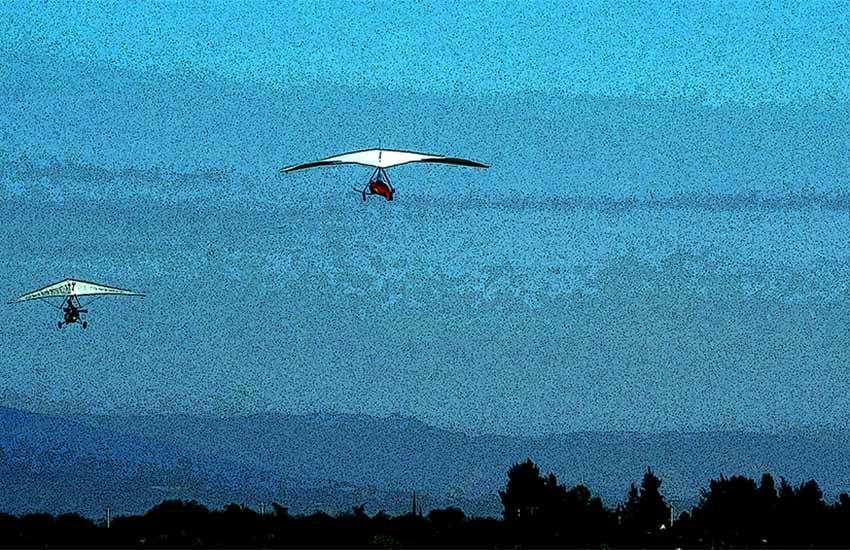
This towing cord is 70 meters long and about half the thickness of a pencil.
“Mile, are you saying this little string is strong enough to take our weight plus the delta wing?”
“Yes,” replied Mile from a distance of 30 centimeters. “It’s made of little strands of nylon woven together.”
“Ain’t technology wonderful!” I commented.” I sure hope it works.”
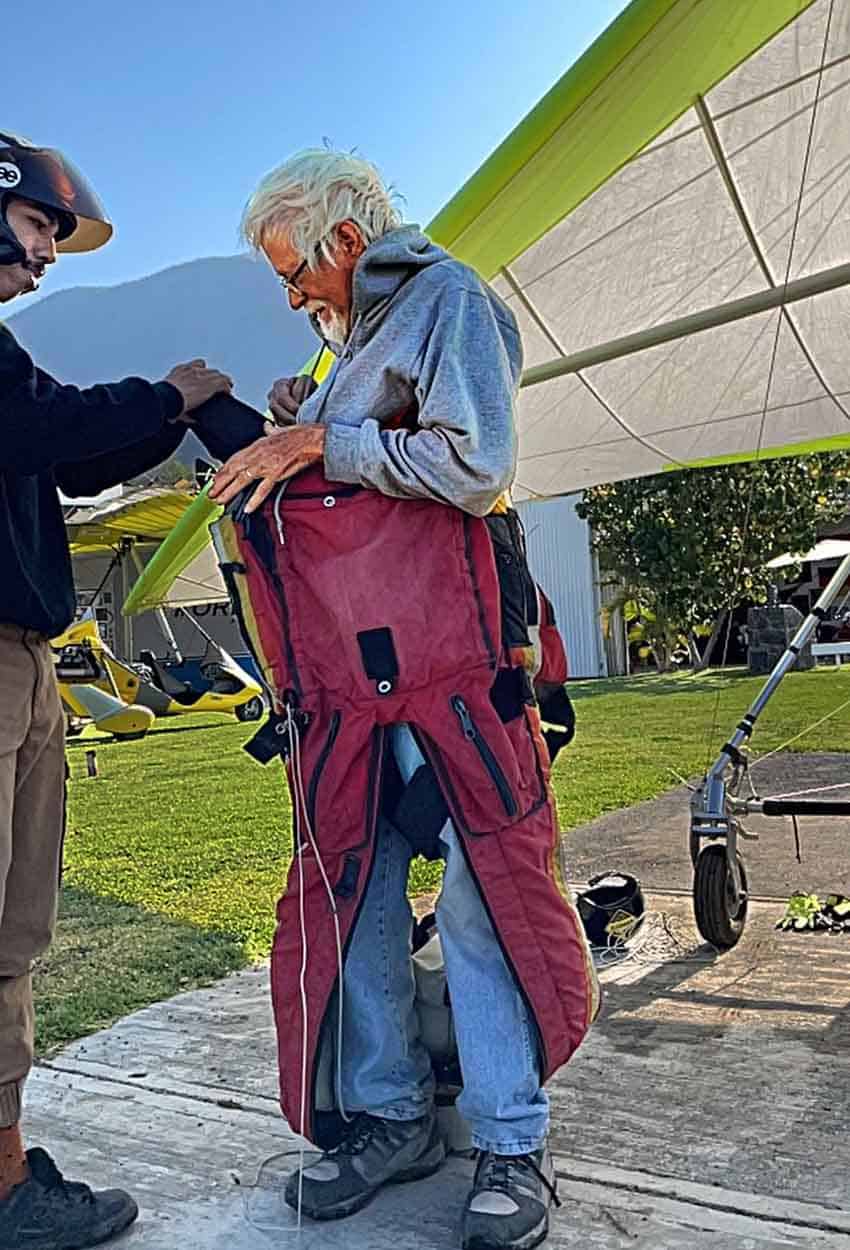
A few minutes later, we rolled along the runway at high speed. This was easy to notice as my nose was only 20 centimeters from the ground.
Pedro Kordich was piloting the trike 70 meters ahead of us, but I couldn’t see him in my horizontal position, unable to lift my head more than two inches; all I could see was the runway for a few seconds, flashing by at high speed.
I’d say only one minute after the towing procedure began, we were so high in the air that cars on the toll road looked the size of ants. Then, suddenly, we were just hanging in the sky, picking out landmarks below us. We didn’t seem to be moving.
“What’s our speed?” I asked, imagining it to be about two kilometers per hour.
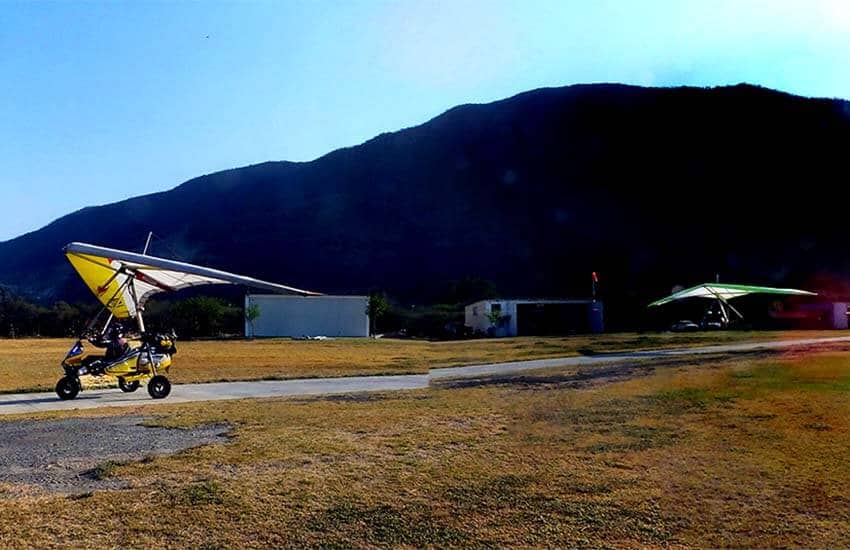
“Sixty-five kilometers per hour,” Mile said.
Up and up we went in a wide spiral that took us higher than the great cliff towering above Los Pozos.
“OK,” said Mile,” I just got the signal from my father. Duck your head ʼcause here comes the towing cord.”
I’m happy to say the cord’s release did not zap us. However, I was paying very little attention to this procedure because in an instant, the roar of the trike engine was gone, and the only sound was the wind whistling.
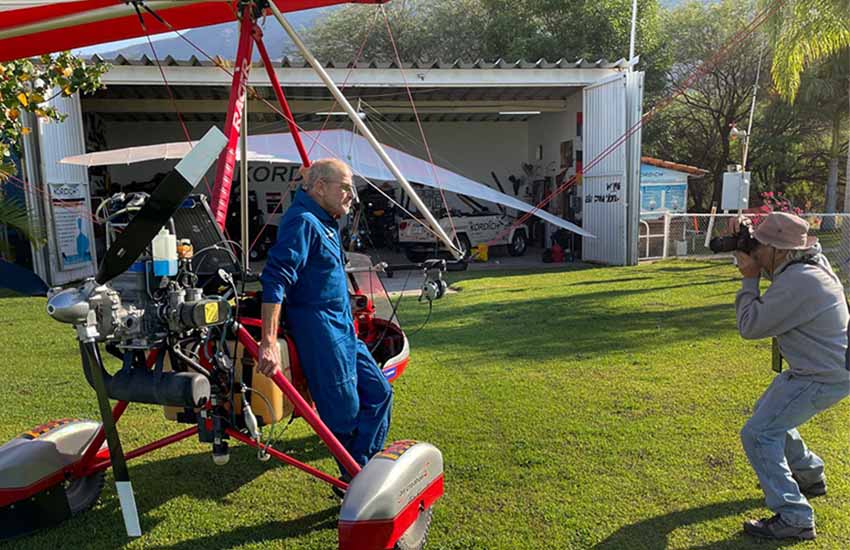
I couldn’t believe it: in no time at all, we were floating — higher than that spot on the clifftop where hang gliding aficionados have launched themselves into the air for years.
We were flying in the morning when conditions were stable, but if it had been the afternoon and Mile had been on his own, this would have been the point where the real fun began: catching those thermals.
When we descended, I was amazed that with a navigation system based entirely on shifting your weight, Mile brought us right down to the edge of that landing strip. Once again, I had the unusual experience of watching the ground whiz by at 20 centimeters below my nose.
I now had a hint, just a tiny idea, of what this sport is all about. As I departed the runway, Mike Weaver, an Ajijic resident who recently purchased his own trike, told me, “I’ve been interested in flying since I was 19, but I didn’t become a pilot until I retired. If I had stayed in the States, I would have found a way to do this over there, but Pedro has made it much easier: all I had to do was move to Mexico!”
“So,” I asked him, “what’s it like flying this thing?”
He didn’t reply immediately. He looked to be doing a Google search in his head of all his life experiences, as well as all the adjectives in his vocabulary. Clearly, the best his mental Google could come up with was “no match” because he finally replied, “Wonderful!” but I knew it didn’t come close to the whole story.
At this point, you might think, “OK, it’s wonderful, but is it safe?”
I asked one of Pedro’s pilots, Dave Naisby, the same question.
“Well, Pedro Kordich has been flying powered hang gliding trikes for 35 years,” he said, “and as far as accidents go, he has a big, fat, solid zero.”
When doing this kind of activity, safety is paramount, he added.
“So you are always looking at the weather; you’re looking at the wind speed. You’re looking at many factors, and the best thing that anybody can do is check all of them and say: ‘Nope, I’m not flying today!’ and walk away.
“This sport is highly addictive. If you do what you’re told, it’s very safe,” he added, “but [after this] every other sport becomes kind of mundane.”
If Naisby’s words pique your curiosity, head for Los Pozos for a 10-minute sample flight. For more info, phone Pedro Kordich (who speaks excellent English) at mobile 331-270-3838 or visit the Kordich Air Facebook page.
The writer has lived near Guadalajara, Jalisco, since 1985. His most recent book is Outdoors in Western Mexico, Volume Three. More of his writing can be found on his blog.
